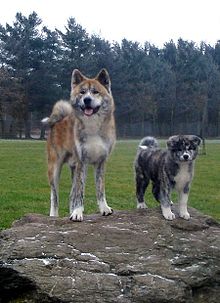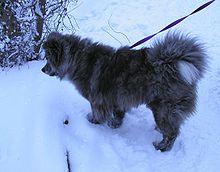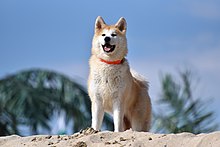
The Akita (秋田犬, Akita-inu, Japanese pronunciation: [akʲita.inɯ]) is a large breed of dog originating from the mountainous regions of northern Japan. There are two separate varieties of Akita: a Japanese strain, commonly called Akita Inu (inu means dog in Japanese) or Japanese Akita, and an American strain, known as the Akita or American Akita.[2] The Japanese strain comes in a narrow palette of colors, with all other colors considered atypical of the breed, while the American strain comes in all dog colors.[3] The Akita has a short double-coat similar to that of many other northern spitz breeds such as the Siberian Husky, but long-coated dogs can also be found in many litters due to a recessive gene.
The Akita is a powerful, independent and dominant breed, commonly aloof with strangers but affectionate with family members. As a breed, Akitas are generally hardy.
In all countries except the United States, the Japanese and American strains of Akita are considered two separate breeds. In the United States, however, the two strains are considered a single breed with differences in type. For a while, the American strain of Akita was known in some countries as the Great Japanese Dog. Both forms of Akita are probably best known worldwide from the true story of Hachikō, a loyal Akita who lived in Japan before World War II.
Breed name[edit]
There is a debate among fanciers whether there are two separate breeds of Akita. To date, only the American Kennel Club,[4] consider American and Japanese Akitas to be two varieties of the same breed, allowing free breeding between the two. The United Kennel Club,[5] The Federation Cynologique Internationale,[6] The Kennel Club,[7][8] the Australian National Kennel Council,[9] the New Zealand Kennel Club,[10][11] and the Japan Kennel Club[citation needed] consider Japanese and American Akitas as separate breeds.[12] Some countries refer to the American Akita as simply the Akita and not the American Akita. The issue is especially controversial in Japan.[13] For the FCI’s 84 countries, the breed split formally occurred June 1999, when the FCI decided that the American type would be called the Great Japanese Dog,[12] later renamed the American Akita in January 2006.[12]
History[edit]
Japanese history[edit]
The dog breed, Akita, originated in the snowy and rural lands of Akita and Odate, mountainous regions of Japan. They were trained to hunt animals such as elks, wild boar, and Ussuri brown bears.[14] This breed in the 1600s was involved in dog fighting, which at the time was popular in Japan. From the 1500s into the 1800s, the Akita served as companions for samurai.[15]
During the early 20th century the Akita was in decline, as a result of being cross bred with the German Shepherd Dog, St. Bernard, Mastiff. As a result, a lot of specimens started to lose their spitz characteristics and instead took on drop ears, straight tails, non-Japanese color (black masks, and any color other than red, white or brindle), and loose skin. A native Japanese breed known as Matagi (hunting dog) was used along with the Hokkaido Inu breed to mix back into the remaining Akita Inu to bring back the spitz phenotype and restore the Akita breed. The modern day Japanese Akita have relatively few genes from western dogs and are spitz in phenotype after the reconstruction of the breed took place, however the larger American breed of Akita largely descends from the mixed Akita before the restoration of the breed, and thus American Akita are typically mixed and not considered true Akita by the Japanese standard.[16]
The Akita were used during the Russo-Japanese War to track prisoners of war and lost sailors.[17] During World War II the Akita was also crossed with German Shepherds in an attempt to save them from the wartime government order for all non-military dogs to be culled.[18] Some were used as scouts and guards during the war.[17] The ancestors of the American Akita were originally a variety of the Japanese Akita, a form that was not desired in Japan due to the markings, and which is not eligible for show competition.[12]
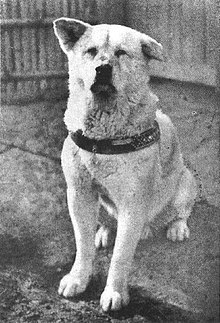
Faithful dog Hachikō was a dog who became legendary in Japan, after waiting every day for his master at Shibuya Station in central Tokyo.
The story of Hachikō, the most revered Akita of all time, helped push the Akita into the international dog world. Hachikō was born in 1923 and owned by Professor Hidesaburō Ueno of Tokyo.[19] Professor Ueno lived near the Shibuya Train Station in a suburb of the city and commuted to work every day on the train.[20] Hachikō accompanied his master to and from the station each day.[20] On May 25, 1925, when the dog was 18 months old, he waited for his master’s arrival on the four o’clock train, but Professor Ueno had a fatal brain haemorrhage at work.[20] Hachikō continued to wait for his master’s return.[20] He travelled to and from the station each day for the next nine years.[20] He allowed the professor’s relatives to care for him, but he never gave up the vigil at the station for his master.[20] His vigil became world-renowned when, in 1934,[21] shortly before his death, a bronze statue was erected at the Shibuya train station in his honor.[20] This statue was melted down for munitions during the war, but a new one was commissioned after the war.[21] Each year on April 8 since 1936, Hachikō’s devotion has been honoured with a solemn ceremony of remembrance at Tokyo’s Shibuya railroad station.[22][23] Eventually, Hachikō’s legendary faithfulness became a national symbol of loyalty, particularly to the person and institution of the Emperor.[24]
In 1931, the Akita was officially declared a Japanese Natural Monument. The Mayor of Odate City in Akita Prefecture organized the Akita Inu Hozonkai to preserve the original Akita as a Japanese natural treasure through careful breeding.[20] In 1934 the first Japanese breed standard for the Akita Inu was listed, following the breed’s declaration as a natural monument of Japan.[25] In 1967, commemorating the 50th anniversary of the founding of the Akita Dog Preservation Society, the Akita Dog Museum was built to house information, documents and photos.[20] There is a tradition in Japan, that when a child is born they receive a statue of an Akita. This statue symbolizes health, happiness, and a long life.[26]

The Akita “Tachibana”,[15] one of the few Akitas to survive the war, pictured here on a Japanese 1953 issue postage stamp.
In 1937, Helen Keller travelled to Japan. She expressed a keen interest in the breed and was presented with the first two Akitas to enter the US.[27] The first dog, presented to her by Mr. Ogasawara and named Kamikaze-go, died at 7 1⁄2 months of age from distemper, one month after her return to the States. A second Akita was arranged to be sent to Miss Keller: Kamikaze’s litter brother, Kenzan-go.[28] Kenzan-go died in the mid-1940s.[29] By 1939 a breed standard had been established and dog shows had been held, but such activities stopped after World War II began.[citation needed] Keller wrote in the Akita Journal:
If ever there was an angel in fur, it was Kamikaze. I know I shall never feel quite the same tenderness for any other pet. The Akita dog has all the qualities that appeal to me he is gentle, companionable and trusty.[30][31]
Just as the breed was stabilizing in its native land, World War II pushed the Akita to the brink of extinction. Early in the war the dogs had a lack of nutritious food. Then many were killed to be eaten by the starving populace, and their pelts were used as clothing. Finally, the government ordered all remaining dogs to be killed on sight to prevent the spread of disease. The only way concerned owners could save their beloved Akitas was to turn them loose in remote mountain areas, where they bred back with their ancestor dogs, the Matagi,[18] or conceal them from authorities by means of crossing with German Shepherds. and naming them in the style of German Shepherds of the time.[18] Morie Sawataishi and his efforts to breed the Akita is a major reason this breed exists today.[32]
During the occupation years following the war, the breed began to thrive again through the efforts of Sawataishi and others.[15] For the first time, Akitas were bred for a standardized appearance.[33] Akita fanciers in Japan began gathering and exhibiting the remaining Akitas and producing litters in order to restore the breed to sustainable numbers and to accentuate the original characteristics of the breed muddied by crosses to other breeds.[34] U.S. servicemen fell in love with the Akita and imported many with them upon their return.
American history[edit]
The Japanese Akita and American Akita began to diverge in type during the Post World War II era.[citation needed] Helen Keller is credited with bringing the Akita to America after being gifted two Akitas by the Japanese government in 1938. A breed standard by 1939 and dog shows began to be held but then World War II began.[35] It was during this time, that US servicemen serving as part of the occupation force in Japan first came into contact with the Akita, the breed so impressed them that many service members chose to bring an Akita back home with them upon completion of their tour.[citation needed] American service members were typically more impressed with the larger more bear-like fighting Akita or German Shepherd type than they were with the smaller framed and fox-like Akita-Inu; the types of dogs they brought back with them to the US reflected this sentiment.[citation needed] Japanese Akita fanciers focused on restoring the breed as a work of Japanese art or to ‘Natural Monument’ status.[citation needed] American Akita fanciers chose to breed larger, heavier-boned and more intimidating dogs.[citation needed] Although, both types derive from a common ancestry, there are marked differences between the two.[36] First, while American Akitas are acceptable in all colors, Japanese Akitas are only permitted to be red, white, or brindle.[citation needed] Additionally, American Akitas may be pinto and/or have black masks, unlike Japanese Akitas where it is considered a disqualification and not permitted in the breed standards.[citation needed] American Akitas generally are heavier boned and larger, with a more bear-like head, whereas Japanese Akitas tend to be lighter and more finely featured with a fox-like head.[12]
Recognized by the American Kennel Club in 1955, it was placed in the Miscellaneous class.[citation needed] It was not until the end of 1972 that the AKC approved the Akita standard and it was moved to the Working dog class, as such, the Akita is a rather new breed in the United States.[citation needed] Foundation stock in America continued to be imported from Japan until 1974 when the AKC cut off registration to any further Japanese imports until 1992 when it recognized the Japan Kennel Club.[citation needed] This decision set the stage for the divergence in type between the American Akita and Japanese Akita Inu that is present today.[citation needed]
Elsewhere in the world, the American Akita was first introduced to the UK in 1937, he was a Canadian import, owned by a Mrs. Jenson, the descendants of Mrs. Jenson live on today breeding American Akitas, the most widely known of them is Mr. Joseph Felton, a widely known and award-winning Akita breeder, however the breed was not widely known until the early 1980s.[29] The breed was introduced in Australia in 1982 with an American Import and to New Zealand in 1986 with an import from the UK.[29]
Description[edit]
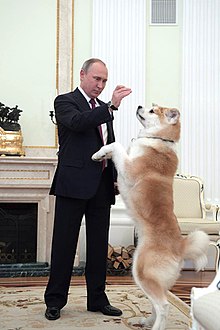
Vladimir Putin with his dog Yume.

Olympic figure skating champion Alina Zagitova receiving a Japanese Akita in a ceremony attended by prime minister Shinzō Abe
Appearance[edit]
As a spitz breed, the appearance of the Akita reflects cold weather adaptations essential to their original function.[37] The Akita is a substantial breed for its height with heavy bones.[38] Characteristic physical traits of the breed include a large, bear-like head with erect, triangular ears set at a slight angle following the arch of the neck.[38] Additionally, the eyes of the Akita are small, dark, deeply set and triangular in shape.[39] Akitas have thick double coats, and tight, well knuckled cat-like feet.[38] Their tails are carried over the top of the back in a gentle or double curl down the loin.[40]
Mature American type males measure typically 26-28 inches (66–71 cm) at the withers and weigh between 100-130 lb (45–59 kg).[38] Mature females typically measure 24-26 inches (61–66 cm) and weigh between 70-100 lb (32–45 kg).[41] The Japanese type, as stated in the breed standards, are a little smaller and lighter.[citation needed]
Breed standards state that all dog breed coat colors are allowable in the American Akita, including pinto, all types of brindle, solid white, black mask, white mask, self-colored mask, even differing colors of under coat and overlay (guard hairs).[42] This includes the common Shiba Inu coloring pattern known as Urajiro.[citation needed] The Japanese Akitas, as per the breed standards, are restricted to red, fawn, sesame, brindle, pure white, all with Urajiro markings whitish coat on the sides of the muzzle, on the cheeks, on the underside of jaw, neck, chest, body and tail and on the inside of the legs.[7]
Coat types[edit]
There are two coat types in the Akita, the standard coat length and the long coat.[43] The long coat is considered a fault in the show ring, however.[43] The long coat, also known as Moku is the result of an autosomal recessive gene and may only occur phenotypically if both sire and dam are carriers. They have longer (about 3-4 inches in length) and softer coats[44] and are known to have sweeter temperaments.[43] It is believed that this gene comes from the now extinct Karafuto-Ken Samurai dog.[45] Unlike their short coat cousins, the long coats are less highly prized and thus more affordable.[46]
Grooming needs[edit]
American Akitas are a low maintenance dog breed. They actually tend to groom themselves like a cat.[47] Grooming them should be an easy process. They are fairly heavy shedders and can go heavier than normal two to three times per year. Specifically, Akitas “blow out” their coats twice a year.[48][49][50] Daily brushing could be a good way to reduce this problem. This breed needs to bathe every few months, although it can be more often, depending on the needs of each owner. Toenails should be trimmed every month, and their ears should be cleaned once a week.
Temperament[edit]
The Akita is generally seen as territorial about its property, and can be reserved with strangers.[51] It is sometimes described as feline in its actions; it is not unusual for an Akita to clean its face after eating, to preen its kennel mate, and to be fastidious in the house.[52] They are known to be intolerant of other dogs of the same sex, as stated in the AKC breed standard.[4]
Since it is a large, powerful dog, the Akita is not considered a breed for a first time dog owner.[51] The breed has been targeted by some countries’ breed-specific legislation as a dangerous dog.[53][54][55][56] The Akita is a large, strong, independent and dominant dog. A well-trained Akita should be accepting of non-threatening strangers, otherwise they will treat all strangers in an aggressive manner.[57] As a breed they should be good with children; it is said that the breed has an affinity for children.[58] Not all Akitas will necessarily have the same temperament.[59][A]
Akitas tend to be reactive towards other dogs, and thus caution must be used in situations when Akitas are likely to be around other dogs, especially unfamiliar ones.[citation needed] In particular, Akitas tend to be less tolerant of dogs of the same sex.[51] For this reason, Akitas, unless highly socialized, are not generally well-suited for off-leash dog parks.[52] Sometimes spontaneous, it needs a confident, consistent handler, without which the dog will be very wilful and may become very aggressive to other dogs and animals.[59]
Training[edit]
The Akita Inu is considered one of the most dominant dog breeds.[62] Therefore, training should start in an early age of seven to eight weeks.[63]
Health[edit]
Autoimmune diseases[edit]
There are many autoimmune diseases that are known to sometimes occur in the Akita. These include, but are not limited to:
- Vogt–Koyanagi–Harada syndrome,[64][65] also known as Uveo-Dermatologic Syndrome is an auto-immune condition which affects the skin and eyes.[66]
- Autoimmune hemolytic anemia,[67] which is an autoimmune blood disorder.[68]
- Sebaceous adenitis[69][70][71] is an autoimmune skin disorder believed to be of autosomal recessive inheritance.[69]
- Pemphigus foliaceus[72] is an autoimmune skin disorder, believed to be genetic.[73]
- Systemic lupus erythematosus (SLE), or lupus, is a systemic autoimmune disease (or autoimmune connective tissue disease) that can affect any part of the body.[74]
Immune-mediated endocrine diseases[edit]
In addition to these there are also the immune-mediated endocrine diseases with a heritable factor, such as:
- Hypoadrenocorticism also known as Addison’s disease, it affects the adrenal glands and is essentially the opposite to Cushing’s syndrome.[75]
- Diabetes mellitus, also known as type 1 diabetes. It affects the pancreas.[75]
- Hypothyroidism,[76] also known as autoimmune hypothyroidism. This is an autoimmune disease which affects the thyroid gland.[77]
Non-immune specific conditions[edit]
Other non-immune specific conditions known to have occurred in the Akita include:
- Gastric dilation is also known as bloat; may progressive to gastric dilatation volvulus (GDV), in which the stomach twists on itself.[78]
- Microphthalmia, meaning “small eyes”, is a developmental disorder of the eye, believed to be an autosomal recessive genetic condition.[79]
- Primary glaucoma,[80] Increased pressure in the eye.[81]
- Progressive retinal atrophy[80][82] progressive degeneration of the retina (portion of the eye that senses light and allows sight).[81]
- Hip dysplasia[67] a skeletal condition where the head of the femur does not fit properly into the hip socket. Leads to osteoarthritis and pain.[83]
- Elbow dysplasia[67] a skeletal condition in which the components of the elbow joint (the humerus, radius, and ulna) do not line up properly, leading to osteoarthritis and pain.[84]
- Von Willebrands disease,[85][86][87] a genetic bleeding disorder caused by a deficiency in Von Willebrand factor.[88]
- Cushing’s Syndrome also known as hyperadrenocorticism, it affects the adrenal glands and is caused by long-term exposure to high levels of glucocorticosteroids, either manufactured by the body or given as medications.[75]
Breed specific conditions[edit]
There are two breed specific conditions mentioned in veterinary literature:
- Immune sensitivity to vaccines, drugs, insecticides, anesthetics and tranquilizers[74]
- Pseudohyperkalemia, a rise in the amount of potassium that occurs due to its excessive leakage from red blood cells (RBCs) when blood is drawn. This can give a false indication of hyperkalemia on lab tests, hence the prefix pseudo, meaning false.[74] This occurs because many East Asian breeds, including Akitas and Shiba Inus, have a higher level of potassium in their RBCs than other dogs.[89]
Working life[edit]
Predecessors of the modern Akita were used for hunting bear, wild boar and deer in Japan as late as 1957.[90] They would be used to flush out the boar and keep it at bay until the hunter could come and kill it. Today, the breed is used primarily as a companion dog. However, the breed is currently also known to be used as therapy dogs,[91] and compete in all dog competitions including: conformation showing, obedience trials, canine good citizen program, tracking trials and agility competition,[92] as well as weight pulling, hunting and Schutzhund (personal protection dogs)
